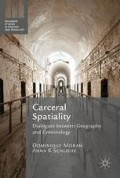Abstract
This book is a hybrid creature. Edited by two human geographers, and published within a Criminology book series, it draws together essays by geographers, some (but not all) of whom are carceral geographers, and criminologists, as well as new collaborations between criminology and geography. Each author, and each set of collaborating authors, has worked somewhat outside of their comfort zone, tackling new literatures, thinking of their research from new perspectives, and engaging in new conversations.
Access this chapter
Tax calculation will be finalised at checkout
Purchases are for personal use only
References
Adey, Peter, Laure Brayer, Damien Masson, Patrick Murphy, Paul Simpson, and Nicolas Tixier. 2013. ‘“Pour votre tranquillité”: Ambiance, atmosphere and surveillance.’ Geoforum 49: 299–309.
Campbell, Elaine. 2012a. ‘Transgression, affect and performance: Choreographing a politics of urban space.’ British Journal of Criminology 53: 18–40.
Campbell, Elaine. 2012b. ‘Landscapes of performance: Stalking as choreography.’ Environment and Planning D: Society and Space 30: 400–417.
Crewe, Ben, Jason Warr, Peter Bennett, and Alan Smith 2014. ‘The emotional geography of prison life.’ Theoretical Criminology 18(1): 56–74.
Davis, Mike. 1990. City of Quartz; Evacuating the Future in Los Angeles. London: Verso.
Davis, Mike. 2006. City of Quartz: Excavating the Future in Los Angeles (New Edition). London: Verso.
Drake, Deborah H., and Rod Earle 2013. ‘On the inside: Prison ethnography around the globe: Deborah H Drake and Rod Earle introduce the articles in the themed section.’ Criminal Justice Matters 91(1): 12–13.
Gill, Nick, Deirdre Conlon, Dominique Moran, and Andrew Burridge. 2016. ‘Carceral circuitry: New directions in carceral geography.’ Progress in Human Geography. doi: 10.1177/0309132516671823.
Hayward, Keith. 2004. ‘Space–the final frontier: Criminology, the city and the spatial dynamics of exclusion.’ In Cultural Criminology Unleashed, edited by Jeff Ferrell, Keith Hayward, Wayne Morrison, and Mike Presdee. Abingdon: Routledge, pp. 155–166.
Hayward, Keith. 2012. ‘Five spaces of cultural criminology.’ British Journal of Criminology 52: 441–462.
Hayward, Keith. 2016. ‘The future of (spatial) criminology and research about public space.’ In Order and Conflict in Public Space, edited by Mattias De Backer, Lucas Melgaço, Georgiana Varna, and Francesca Menichelli. Abingdon: Routledge, pp. 207–215.
Kindynis, Theo. 2014. ‘Ripping up the map: Criminology and cartography reconsidered.’ British Journal of Criminology 54(2): 222–243.
Kindynis, Theo. 2016. ‘Urban exploration: From subterranea to spectacle.’ British Journal of Criminology. Early Online. doi: 10.1093/bjc/azw045.
Moran, Dominique, Jennifer Turner, and Anna Schliehe. (forthcoming). Conceptualising the carceral in carceral geography. Progress in Human Geography.
Shabazz, Rashad. 2009. ‘“So high you can’t get over it, so low you can’t get under it”: Carceral spatiality and black masculinities in the United States and South Africa.’ Souls 11: 276–294.
Shabazz, Rashad. 2015a. Spatializing Blackness: Architectures of Confinement and Black Masculinity in Chicago. Chicago, IL: University of Illinois Press.
Shabazz, Rashad. 2015b. ‘“Sores in the city”: A genealogy of the Almighty Black P. Stone Rangers.’ In Historical Geographies of Prisons: Unlocking the Usable Carceral Past, edited by Karen M Morin and Dominique Moran. Abingdon: Routledge, pp. 51–68.
Smith, Caleb. 2013. ‘Spaces of punitive violence.’ Criticism 55(1): 161–168.
Wacquant, Loïc. 2009. Prisons of Poverty. Minneapolis: University of Minnesota Press.
Author information
Authors and Affiliations
Corresponding author
Editor information
Editors and Affiliations
Copyright information
© 2017 The Author(s)
About this chapter
Cite this chapter
Moran, D., Schliehe, A.K. (2017). Introduction: Co-production and Carceral Spatiality. In: Moran, D., Schliehe, A. (eds) Carceral Spatiality. Palgrave Studies in Prisons and Penology. Palgrave Macmillan, London. https://doi.org/10.1057/978-1-137-56057-5_1
Download citation
DOI: https://doi.org/10.1057/978-1-137-56057-5_1
Published:
Publisher Name: Palgrave Macmillan, London
Print ISBN: 978-1-137-56056-8
Online ISBN: 978-1-137-56057-5
eBook Packages: Law and CriminologyLaw and Criminology (R0)

